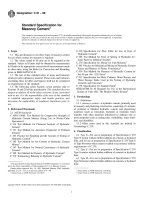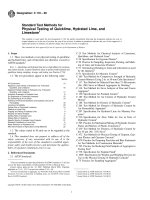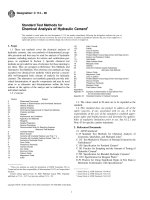Designation: C 359 – 99 - Early Stiffening of Portland Cement (Mortar Method)1 pot
Bạn đang xem bản rút gọn của tài liệu. Xem và tải ngay bản đầy đủ của tài liệu tại đây (34.16 KB, 3 trang )
Designation: C 359 – 99
Standard Test Method for
Early Stiffening of Portland Cement (Mortar Method)
1
This standard is issued under the fixed designation C 359; the number immediately following the designation indicates the year of
original adoption or, in the case of revision, the year of last revision. A number in parentheses indicates the year of last reapproval. A
superscript epsilon (e) indicates an editorial change since the last revision or reapproval.
1. Scope
1.1 This test method covers the determination of early
stiffening in portland-cement mortar.
1.2 The values stated in SI units are the standard. The values
in parentheses are for information only.
1.3 This standard does not purport to address all of the
safety concerns, if any, associated with its use. It is the
responsibility of the user of this standard to establish appro-
priate safety and health practices and determine the applica-
bility of regulatory limitations prior to use. See Note 1 for a
specific warning statement.
NOTE 1—Warning: Fresh hydraulic cementitious mixtures are caustic
and may cause chemical burns to skin and tissue upon prolonged
exposure. The use of gloves, protective clothing, and eye protection is
recommended. Wash contact area with copious amounts of water after
contact. Wash eyes for a minimum of 15 min. Avoid exposure of the body
to clothing saturated with the liquid phase of the unhardened material.
Remove contaminated clothing immediately after exposure.
2. Referenced Documents
2.1 ASTM Standards:
C 150 Specification for Portland Cement
2
C 183 Practice for Sampling and the Amount of Testing of
Hydraulic Cement
2
C 185 Test Method for Air Content of Hydraulic Cement
Mortar
2
C 187 Test Method for Normal Consistency of Hydraulic
Cement
2
C 305 Practice for Mechanical Mixing of Hydraulic Cement
Pastes and Mortars of Plastic Consistency
2
C 490 Practice for Use of Apparatus for the Determination
of Length Change of Hardened Cement Paste, Mortar, and
Concrete
2
C 670 Practice for Preparing Precision and Bias Statements
for Test Methods for Construction Materials
3
C 778 Specification for Standard Sand
2
C 1005 Specification for Reference Masses and Devices for
Determining Mass for Use in the Physical Testing of
Hydraulic Cements
2
D 1193 Specification for Reagent Water
4
E 1 Specification for ASTM Thermometers
5
3. Terminology
3.1 Definitions:
3.1.1 early stiffening—the early development of stiffness in
the working characteristics of a portland-cement paste, mortar,
or concrete. Varieties include false set and flash set.
3.1.2 false set—the early development of stiffness in the
working characteristics of a portland-cement paste, mortar, or
concrete without the evolution of much heat, which stiffness
can be dispelled and plasticity regained by further mixing
without addition of water; also known as “grab set,”“ prema-
ture stiffening,” “hesitation set,” and “rubber set.”
3.1.3 flash set—the early development of stiffness in the
working characteristics of a portland-cement paste, mortar, or
concrete, usually with the evolution of considerable heat,
which stiffness cannot be dispelled nor can the plasticity be
regained by further mixing without addition of water; also
known as “quick set.”
4. Summary of Test Method
4.1 A mortar is prepared with the cement to be tested, using
specified quantities of cement, standard sand, and water. Using
the modified Vicat apparatus, measurements of penetration are
made at stipulated intervals after the beginning of the mixing
procedure. Upon completion of the first series of penetration
measurements, the mortar is returned to the mixer to be
remixed. Following the remix procedure, an additional pen-
etration, termed the remix penetration, is determined. The
report is a tabulation of the penetration measurements.
5. Significance and Use
5.1 The purpose of this test method is to determine the
degree to which a cement mortar develops early stiffening. It is
intended primarily for use by those interested in research on
methods for determining the potential false set of portland
cement.
5.2 When used for estimating the relative tendency of a
cement to manifest early stiffening, a judgment may be made
by comparing the behavior in the penetration series (see 10.4.1
and 10.4.2) and the remix procedure (see 10.4.3) to differen-
tiate a relatively less serious and less persistent tendency to
1
This test method is under the jurisdiction of ASTM Committee C-1 on Cement
and is the direct responsibility of Subcommittee C01.30 on Time of Set.
Current edition approved Jan. 10, 1999. Published May 1999. Originally
published as C 359 – 55 T. Last previous edition C 359 – 89 (1995)
e1
.
2
Annual Book of ASTM Standards, Vol 04.01.
3
Annual Book of ASTM Standards, Vol 04.02.
4
Annual Book of ASTM Standards, Vol 11.01.
5
Annual Book of ASTM Standards, Vol 14.03.
1
AMERICAN SOCIETY FOR TESTING AND MATERIALS
100 Barr Harbor Dr., West Conshohocken, PA 19428
Reprinted from the Annual Book of ASTM Standards. Copyright ASTM
early stiffening from one that is more persistent and, conse-
quently, more serious.
5.3 Severe false setting in a cement may cause difficulty
from a placing and handling standpoint, but it is not likely to
cause difficulties where concrete is mixed for a longer time
than usual, as usually occurs in transit mixing, or where it is
remixed prior to placing or transporting, in concrete pumping
operations. It is most likely noticed where concrete is mixed
for a short period of time in stationary mixers and transported
to the forms in nonagitating equipment, as on some paving
jobs.
5.4 Cements with severe false setting usually require
slightly more mixing water to produce the same consistency,
which may result in slightly lower strengths and increased
drying shrinkage.
5.5 Flash set of a severity sufficient to cause difficulties from
a placing and handling standpoint usually will cause the
cement to fail the requirements for time of setting in Specifi-
cation C 150.
6. Apparatus
6.1 Vicat Apparatus, conforming to the requirements of Test
Method C 187, with the following modifications:
6.1.1 The 1-mm needle shall be replaced by a weight, such
that the total weight of the 10-mm plunger, indicator, and
added weight shall be 400 6 0.5 g.
6.2 Spoon, conforming to the requirements of Test Method
C 185.
6.3 Mixer, Bowl, Paddle, and Scraper, conforming to the
requirements of Practice C 305.
6.4 Glass Graduates, conforming to the requirements of
Specification C 490.
6.5 Masses and Mass Determining Devices , conforming to
the requirements of Specification C 1005.
6.6 Thermometer, ASTM No. 1C or 1F, conforming to the
requirements of Specification E 1.
6.7 Trowel, having a steel blade 100 to 150 mm (4 to 6 in.)
in length, with a straightedge.
6.8 Clock Timer.
6.9 Containers, approximately 50 by 50 by 150 mm (2 by 2
by 6 in.) inside dimensions (Fig. 1). These containers, which
may be made of any suitable materials such as sheet metal or
plastic, shall be rigid, watertight, and at least 50 mm (2 in.)
deep.
7. Reagents and Materials
7.1 Standard Sand, 20-30 and Graded, conforming to the
requirements of Specification C 778.
7.2 Mixing Water—Potable water is satisfactory for routine
tests. For all referee and cooperative tests, reagent water
conforming to the requirements of Specification D 1193 for
Type III or Type IV grades of reagent water shall be used.
8. Sampling
8.1 Sample the cement in accordance with Methods C 183.
9. Conditioning
9.1 The temperature of the room, dry materials, paddle,
bowl, and containers shall be maintained between 20 and
27.5°C (68 and 81.5°F). The temperature of the mixing water
shall not vary from 23°C (73.4°F) by more than 61.7°C
(63°F).
9.2 The relative humidity of the laboratory shall not be less
than 50 %.
10. Procedure
10.1 Batch—Mix at one time 600 g of cement, 300 g of
graded standard sand, 300 g of 20-30 standard sand, and 180
mL of water for all cements except Types III and IIIA, for
which the amount of water shall be 192 mL.
10.2 Mixing of Mortar—The mixing shall be done in the
mechanical mixer as follows:
10.2.1 Place the sand and cement in the dry bowl, and mix
the dry materials for a few seconds with the spoon.
10.2.2 Place the bowl in the mixer, set the paddle in place,
and mix the dry materials for 10 s at a slow speed (140 6 5
r/min).
10.2.3 With the mixer operating at a slow speed (1406 5
r/min), add the entire quantity of mixing water within 5 s. Stop
the mixer, quickly change to a medium speed (285 6 10
r/min), and continue the mixing for 1 min, timing from the first
addition of water.
10.2.4 Stop the mixer, scrape the sides of the mixing bowl
with the rubber scraper, and quickly place the thermometer in
the mortar. Allow it to stand undisturbed for the remainder of
a 45-s interval from the time of stopping the mixer.
10.2.5 Read the temperature, remove the thermometer, start
the mixer, and mix for 15 s at a medium speed (285 6 10
r/min). If the mortar temperature is not in the range from 23 6
1.7°C (73.46 3°F), discard the batch and adjust the tempera-
ture of the water or sand, or both, to give the required
temperature.
10.3 Filling Container:
10.3.1 Immediately after completion of the mixing, remove
the bowl from the mixer and with a spoon, uniformly distribute
a portion of the mortar into the container until the container is
heaping full. Quickly and gently place each spoonful of mortar
in the container. When removing the mortar from the bowl, do
not remove the material pushed up on the side of the bowl by
the paddle. After the container has been filled, reassemble the
mixer, cover the bowl with a lid, and retain the remaining
mortar for a remix test to be performed later. To compact the
mortar in the container, lift the container approximately 80 mm
(3 in.) from the table with both hands and rap it twice against
FIG. 1 Container for Early Stiffening Tests
C 359
2
the surface of the table.
10.3.2 With the leading edge slightly raised, strike off the
mortar with one stroke of the trowel along the length of the
container. Then remove the excess mortar by means of a
sawing motion with the straightedge of the trowel along the
length of the container in a direction opposite to that used in
striking off. Then, smooth the surface of the mortar with a
single stroke of the trowel.
10.4 Penetration Tests:
10.4.1 After filling the container, immediately place the
10-mm plunger of the Vicat apparatus, Fig. 1 of Test Method
C 187, in contact with the surface of the mortar at the midpoint
of the container on the longitudinal center line. Set the movable
indicator at zero. Release the plunger 3 min after the beginning
of the wet mixing and record, as the initial penetration, the
depth in millimetres to which the plunger has settled below the
surface 10 s after being released. Generally, the plunger will
settle to the bottom of the container, and the initial penetration
will, accordingly, be recorded as 50 + mm.
10.4.2 Immediately withdraw and clean the plunger. In a
similar manner, determine, after moving the Vicat apparatus to
the desired location, the penetrations at intervals of 5, 8, and 11
min after the beginning of mixing. Do not move the filled
container until these measurements are completed. Make all
penetrations along the longitudinal center line of the container.
Obtain 5 and 8-min penetrations at a distance of approximately
40 mm (1
1
⁄
2
in.) from each end of the container, respectively,
and determine the 11-min penetration at a point approximately
midway between the points at which the initial and 5-min
penetrations were determined.
10.4.3 At the completion of the measurement of the 11-min
penetration, immediately return the mortar in the container to
the bowl. Start the mixer, raise the bowl into mixing position,
and remix the contents of the bowl at medium speed (285 6 10
r/min) for 1 min. Fill a clean container as outlined in 10.3.1 and
10.3.2, and determine the penetration 45 s after completion of
mixing.
11. Report
11.1 The report shall show the depths of the penetrations as
follows:
Initial penetration ___mm
5-min penetration ___mm
8-min penetration ___mm
11-min penetration ___mm
Remix penetration ___mm
12. Precision and Bias
12.1 Interlaboratory test data for the determination of state-
ments of precision and bias in accordance with Practice C 670
are being evaluated by Subcommittee C01.30. Statements of
precision and bias will be included in a later revision of this test
method.
NOTE 2—For additional useful information on details of cement test
methods, reference may be made to the “Manual of Cement Testing,”
which appears in the Annual Book of ASTM Standards, Vol 04.01.
13. Keywords
13.1 early stiffening; false set; flash set; portland-cement
mortar
The American Society for Testing and Materials takes no position respecting the validity of any patent rights asserted in connection
with any item mentioned in this standard. Users of this standard are expressly advised that determination of the validity of any such
patent rights, and the risk of infringement of such rights, are entirely their own responsibility.
This standard is subject to revision at any time by the responsible technical committee and must be reviewed every five years and
if not revised, either reapproved or withdrawn. Your comments are invited either for revision of this standard or for additional standards
and should be addressed to ASTM Headquarters. Your comments will receive careful consideration at a meeting of the responsible
technical committee, which you may attend. If you feel that your comments have not received a fair hearing you should make your
views known to the ASTM Committee on Standards, 100 Barr Harbor Drive, West Conshohocken, PA 19428.
C 359
3
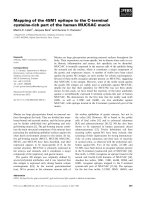


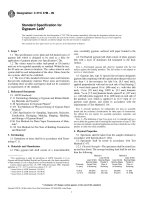
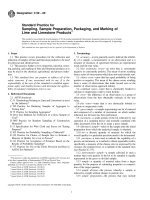
![Designation: C 109/C 109M – 99 - Compressive Strength of Hydraulic Cement Mortars (Using 2-in. or [50-mm] Cube Specimens)1 pps](https://media.store123doc.com/images/document/2014_07/10/medium_tyk1405009245.jpg)
